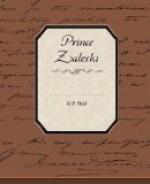It was at this point that the black mask of Ham framed itself between the python-skin tapestries of the doorway. I tore from him the paper, now two days old, which he held in his hand, and under the heading, ‘Sudden death of a Baronet,’ read a nearly exact account of the facts which Zaleski had been detailing to me.
‘I can see by your face that I was not altogether at fault,’ he said, with one of his musical laughs; ’but there still remains for us to discover whence Ul-Jabal obtained his two substitutes, his motive for exchanging one for the other, and for stealing the valueless gem; but, above all, we must find where the real stone was all the time that these two men so sedulously sought it, and where it now is. Now, let us turn our attention to this stone, and ask, first, what light does the inscription on the cup throw on its nature? The inscription assures us that if “this stone be stolen,” or if it “chaunges dre,” the House of Saul and its head “anoon” (i.e. anon, at once) shall die. “Dre,” I may remind you, is an old English word, used, I think, by Burns, identical with the Saxon “dreogan,” meaning to “suffer.” So that the writer at least contemplated that the stone might “suffer changes.” But what kind of changes—external or internal? External change—change of environment—is already provided for when he says, “shulde this Ston stalen bee”; “chaunges,” therefore, in his mind, meant internal changes. But is such a thing possible for any precious stone, and for this one in particular? As to that, we might answer when we know the name of this one. It nowhere appears in the manuscript, and yet it is immediately discoverable. For it was a “sky-blue” stone; a sky-blue, sacred stone; a sky-blue, sacred, Persian stone. That at once gives us its name—it was a turquoise. But can the turquoise, to the certain knowledge of a mediaeval writer, “chaunges dre”? Let us turn for light to old Anselm de Boot: that is he in pig-skin on the shelf behind the bronze Hera.’




